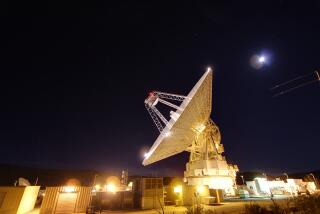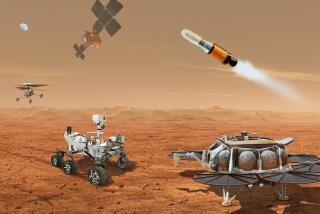Doubling of NASA Funding Urged : U.S. Risks Being Second-Class Space Power, Group Warns
WASHINGTON — The United States must approximately double its spending on the civilian space program or risk sliding into the position of a second-class space power, an influential association of aerospace engineers and scientists declared Wednesday.
Although it endorsed the Reagan Administration’s moves to replace the space shuttle Challenger and to increase the nation’s use of unmanned rockets to launch satellites, the 40,000-member American Institute of Astronautics and Aeronautics suggested that current planning is in the hands of officials who are unable to develop national policy.
Two-Day Seminar
The recommendation and the criticism were contained in a report based on a two-day seminar organized by the institute to evaluate the American space program in light of the Challenger disaster and the subsequent failure of two unmanned satellite launchings.
NASA Administrator James C. Fletcher, in Salt Lake City for a speech Wednesday, brushed aside the suggestion of doubling NASA’s budget, which is about $7.6 billion for the current fiscal year. “We can’t go out and say double NASA’s budget in a period like this,” he said.
As Fletcher was trying to deflect the report’s criticism Wednesday, NASA disclosed yet another launching failure.
The agency said that an Aries rocket carrying a scientific payload in a suborbital flight was destroyed 50 seconds after launching last Saturday at White Sands Missile Range in New Mexico. An announcement said that “there appeared to be a problem in the launch vehicle’s guidance system” and that a signal from the range safety officer destroyed the rocket at an altitude of 77,000 feet.
‘No-Growth’ Policy
In its report on the space program, which was released at a Washington press conference, the institute of space experts said: “The current no-growth budget policy will ensure that the U.S. becomes and remains a second-class power in space.
“If space preeminence is a national objective, therefore, the choice is not simply to select among the fixed-budget alternatives of replacing the Challenger, reestablishing expendable launch vehicle capability, development of a next-generation launch system or deploying the space station, but to commit the funding needed to proceed with all the necessary actions at a pace commensurate with the national objective.
“The national perspective necessary for such decisions does not exist in the Administration’s present policy-setting structure . . . .”
Singled out for criticism was the Senior Interagency Group, which earlier this month produced a plan for replacing the Challenger shuttle lost in the Jan. 28 disaster and taking the National Aeronautics and Space Administration out of the business of launching commercial satellites.
Cabinet Rank Proposed
Instead of relying on the interagency group, the institute recommended that the United States bring back the National Aeronautics and Space Council, which provided space policy advice in the 1960s, and create a new Cabinet-level department.
Jerry Grey, publisher of the institute’s journal, Aerospace Today, said that there was much agreement with the report’s recommendations, although government officials took issue with the call for a new Cabinet-level department or reconstituted National Aeronautics and Space Council.
Before it was made public, the report was submitted to top Administration officials concerned with space policy, including Fletcher.
Meanwhile, NASA made available Fletcher’s reply to another advisory report, which several days ago criticized the space agency for the pace of its recovery from the shuttle accident.
In a letter to NASA Advisory Council Chairman Daniel J. Fink, Fletcher declared: “I did not return to NASA to preside over its decline to second-class status in the hierarchy of space-faring nations. It is my intent to see that our launch capability is rebuilt, that we restock our reservoirs of advanced space technology and that we use those capabilities to return to the forefront of human space activity.”
The suborbital Aries flight destroyed on Saturday carried a 2,300-pound telescope that was supposed to have studied X-ray emissions from distant stars for a period of about six minutes.
Series of Failures
The destruction of the rocket was the latest in a series of American space rocket failures that began with the loss of the Challenger and its seven-member crew on Jan. 28.
On April 18, an Air Force Titan 34-D rocket carrying a military satellite exploded seconds after liftoff, and on May 3 a Delta rocket went out of control and was destroyed by the range safety officer shortly after it lifted off from Cape Canaveral, Fla., with a weather satellite.
Another small rocket, a Nike-Orion, failed as it lofted a science payload on a suborbital flight from White Sands on April 25.
Aries was developed by NASA and the Department of Defense and is manufactured by Space Vector Corp. of Northridge, Calif.
More to Read
Sign up for Essential California
The most important California stories and recommendations in your inbox every morning.
You may occasionally receive promotional content from the Los Angeles Times.










